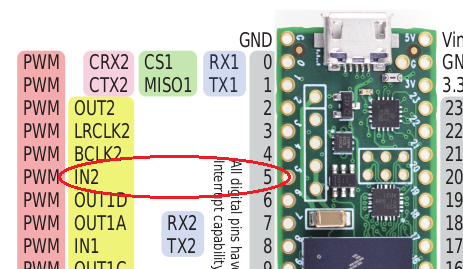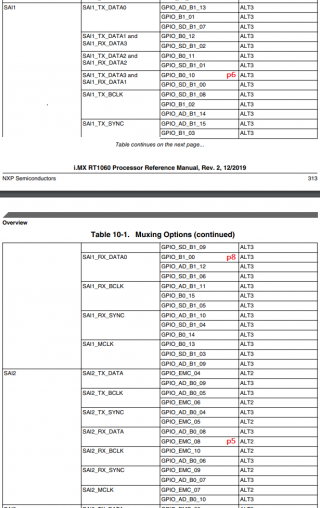chipaudette
Well-known member
I'm still trying to get my T4.1 (beta) to do 4 channel audio using two of the RevD Teensy Audio Shields. I'm successful in getting audio output of the system, but I can't seem to get audio into the system. Has anyone successfully gotten 4 channels of audio into their T4.x using I2S?
To get Quad audio working with the Teensy Audio boards, one needs to modify the second board. Similar to this post, here are the modifications that I performed:
* Cut the trace between the two pads for the audio board's RX (Pin 7)
* Cut the tracce between the two pads for the audio board's TX (Pin 8)
* Remove the 10K resistor connected to Pin 6
* Add a wire from pin 6 over to the pad that had been connected to pin 8
* Add a wire from pin 32 to the pad that had been connected to pin 7
* Cut the trace between the 3 pads that set the audio shield's address (was LOW)
* Solder-bridge the center pad to the other pad (sets the address to HIGH)
For software, I loaded up the Audio library example sketch PassThruQuad. This sketch is set to route audio that is input (line-in) into one board and send it to the output (headphone) of the other board. This seems like a good test of my setup.
So, my setup is one T4.1 (beta) plus one unmodified audio board (board #1) plus one modified board (board #2). With this setup, I am successful with injecting audio into board #1 and hearing it from board #2. So, the output of my modified board is fine. But, I am not successful with injecting audio into board #2 and hearing it from board #1. So, the input of my modified board is not working.
[By rerouting the connections, I've confirmed that the output of the unmodified board does work. The only thing that doesn't work is the input to the modified board.]
Since user error is always the best answer, I removed my modified board and inserted a different board that I modified. I got the same negative result. While user error is still a possible answer, now I am suspecting the software.
Has anyone successfully gotten quad audio input to work via I2S on their T4.1? What connections did you use? Was there a trick?
Chip
To get Quad audio working with the Teensy Audio boards, one needs to modify the second board. Similar to this post, here are the modifications that I performed:
* Cut the trace between the two pads for the audio board's RX (Pin 7)
* Cut the tracce between the two pads for the audio board's TX (Pin 8)
* Remove the 10K resistor connected to Pin 6
* Add a wire from pin 6 over to the pad that had been connected to pin 8
* Add a wire from pin 32 to the pad that had been connected to pin 7
* Cut the trace between the 3 pads that set the audio shield's address (was LOW)
* Solder-bridge the center pad to the other pad (sets the address to HIGH)
For software, I loaded up the Audio library example sketch PassThruQuad. This sketch is set to route audio that is input (line-in) into one board and send it to the output (headphone) of the other board. This seems like a good test of my setup.
So, my setup is one T4.1 (beta) plus one unmodified audio board (board #1) plus one modified board (board #2). With this setup, I am successful with injecting audio into board #1 and hearing it from board #2. So, the output of my modified board is fine. But, I am not successful with injecting audio into board #2 and hearing it from board #1. So, the input of my modified board is not working.
[By rerouting the connections, I've confirmed that the output of the unmodified board does work. The only thing that doesn't work is the input to the modified board.]
Since user error is always the best answer, I removed my modified board and inserted a different board that I modified. I got the same negative result. While user error is still a possible answer, now I am suspecting the software.
Has anyone successfully gotten quad audio input to work via I2S on their T4.1? What connections did you use? Was there a trick?
Chip
Last edited:




















